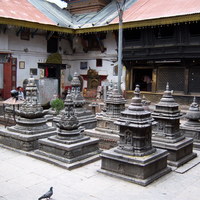Papers by Nishikant Kolge
Gandhi: An Imperfect Philosopher , 2022
The Politician: A Response to Arundhati Roy's The Doctor and The Saint
ABSTRACT
The Right of Revolution in Gandhi and Lincoln
A conceptual history of Gandhi’s Satyagraha
Tadbhav, Year 8, No 40 , 2019
One can legitimately ask if there is scope for another essay on Gandhi. So much has been written ... more One can legitimately ask if there is scope for another essay on Gandhi. So much has been written on this iconic man; so many facets of his remarkable life, both in the public realm and private, have been widely discussed and published. One may therefore feel that there is nothing left to be said about his life and philosophy. However, one must also admit that rather than bringing clarity to his life and philosophy, these enormous works have created much confusion and ambiguity.
EPW, 2021
for reading and commenting on earlier drafts of this paper. Especially so, to Guha for also provi... more for reading and commenting on earlier drafts of this paper. Especially so, to Guha for also providing much-needed and extensive editorial support to this paper. All errors and conclusions contained herein are of the author's alone.
Gandhi: the Mixture Was the Essence
Journal of Dharma Studies
The Politician
Oxford Scholarship Online
This paper looks closely at Arundhati Roy’s introduction entitled ‘The Doctor and the Saint’ to t... more This paper looks closely at Arundhati Roy’s introduction entitled ‘The Doctor and the Saint’ to the annotated edition of Annihilation of Caste originally authored by Dr. B.R. Ambedkar. The paper argues that the basic problem in Roy’s analysis is that from the very outset she assumes (by her own confession she has been raised on a diet of Gandhi hagiographies) Gandhi was a...
Critical analysis
Oxford Scholarship Online
This chapter critically evaluates Gandhi’s overall strategy to abolish the caste system in order ... more This chapter critically evaluates Gandhi’s overall strategy to abolish the caste system in order to understand its continued relevance for the uplifment of untouchables/dalit during the present times. For this purpose, it places Gandhi’s strategy in contrast with two other contemporary movements, the Arya Samaj’s Shuddhi movement and Ambedkar’s anti-caste movement. It examines the divergences between Gandhi’s strategy and the other two approaches and in doing so highlights the limitations as well as merits of Gandhi’s approach. The first section explains the difference between Gandhi’s and Ambedkar’s strategy. The second section differentiates between Gandhi’s strategy and Arya Samaj’s Shuddhi movement.

What did Gandhi stand for and what did he intend to achieve?
Oxford Scholarship Online
The second chapter aims to understand what, if not the caste system or varnashramadharma, was the... more The second chapter aims to understand what, if not the caste system or varnashramadharma, was the basis of Gandhi’s ideal society and ideal form of organizing human society which he aspired to achieve. The chapter unfolds its investigation in three sections. The first section argues that Gandhi developed his basic idea about ideal society, form of ideal governance, and so on during his twenty-one year stay in South Africa and expressed them in his seminal work Hind Swaraj. The second section argues that if Hind Swaraj is studied as Gandhi’s effort to define what Swaraj is, it will be helpful to paint a comprehensive picture of Gandhi’s ideal society. As such, the third section of this chapter attempts to understand the notion of Swaraj as held by Gandhi and concludes that it was not parliamentary Swaraj based on the modern state or Hinduraj based on varnashramadharma but the self-derived autonomy of an individual that Gandhi advocated and aspired to achieve.

Was there a strategy in Gandhi’s approach to fight against the caste system?*
Oxford Scholarship Online
The chapter argues that despite enormous difficulties that different scholars had faced in assess... more The chapter argues that despite enormous difficulties that different scholars had faced in assessing Gandhi’s views on the problem of the caste system and untouchability due to inconsistency in his writings, the subject needs to be thoroughly examined by studying his practices too. The first part of the chapter examines Gandhi’s practice on different caste restrictions and some other religious obligations, while the second part of the chapter looks at the community life in Gandhi’s four Ashrams. The third part of the chapter analyses different arguments and justifications presented by different scholars regarding Gandhi’s views on the caste system. On examining these arguments and the justifications offered by different scholars in the light of Gandhi’s practice the chapter argues it is only appropriate to hold Rajmohan Gandhi’s and few other scholars’ view that for strategic reason alone Gandhi emphasizes on the positive aspect of the caste system after coming from South Africa.

Gandhi’s evolving strategy to abolish the caste system: Part II
Oxford Scholarship Online
This chapter expounds the course of Gandhi’s evolving strategy against the caste system within it... more This chapter expounds the course of Gandhi’s evolving strategy against the caste system within its historical context. It presents a chronological account of Gandhi’s writings and life starting from 1932 (his epic fast unto death) to 1948 (his death). It analyses Gandhi’s writings during two periods, viz., 1932 to 1945, and 1945 to 1948, on the themes that emerge during those years on issues of untouchability, caste, varna, sanatani Hindu, inter-dining, and inter-caste marriage. Each section that studies the above-mentioned time periods is further divided into two sub-sections, the first on the historical background of the changing political context of each period, which in turn served to advance his movement against the caste system gradually, and second on how these themes themselves appear to shift in Gandhi’s writings. At the end the chapter also presents an overview of Gandhi’s strategy.

Gandhi Against Caste
Oxford Scholarship Online
In 1909, while still in South Africa, Gandhi publicly decried the caste system for its inequaliti... more In 1909, while still in South Africa, Gandhi publicly decried the caste system for its inequalities. Shortly after his return to India though, he spoke of the generally beneficial aspects of caste. Gandhi’s writings on caste reflect contradictory views and his critics accuse him of neglecting the unequal socio-economic structure that relegated Dalits to the bottom of the caste hierarchy. So, did Gandhi endorse the fourfold division of the Indian society or was he truly against caste? In this book, Nishikant Kolge investigates the entire range of what Gandhi said or wrote about caste divisions over a period of more than three decades: from his return to India in 1915 to his death in 1948. Interestingly, Kolge also maps Gandhi’s own statements that undermined his stance against the caste system. These writings uncover the ‘strategist Gandhi’ who understood that social transformation had to be a slow process for the conservative but powerful section of Hindus who were not yet ready for...
Gandhi’s Criticism of Industrialization and Modernity; An Environmental Perspective
Gandhi viewed life as a whole. He did not divide life into different watertight compartments like... more Gandhi viewed life as a whole. He did not divide life into different watertight compartments like political, religious, economics and so on. What he had said about politics must be largely applicable in religion, economics and many other fields of human life as well. ...
GAndhi's Crticism of Industrialisation and Modernity: En Environmental Perspective
Gandhi: the Mixture Was the Essence
Journal of Dharma Studies











Uploads
Papers by Nishikant Kolge